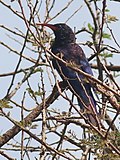Superregnum: Eukaryota
Cladus: Unikonta
Cladus: Opisthokonta
Cladus: Holozoa
Regnum: Animalia
Subregnum: Eumetazoa
Cladus: Bilateria
Cladus: Nephrozoa
Superphylum: Deuterostomia
Phylum: Chordata
Subphylum: Vertebrata
Infraphylum: Gnathostomata
Megaclassis: Osteichthyes
Cladus: Sarcopterygii
Cladus: Rhipidistia
Cladus: Tetrapodomorpha
Cladus: Eotetrapodiformes
Cladus: Elpistostegalia
Superclassis: Tetrapoda
Cladus: Reptiliomorpha
Cladus: Amniota
Classis: Reptilia
Cladus: Eureptilia
Cladus: Romeriida
Subclassis: Diapsida
Cladus: Sauria
Infraclassis: Archosauromorpha
Cladus: Crurotarsi
Divisio: Archosauria
Cladus: Avemetatarsalia
Cladus: Ornithodira
Subtaxon: Dinosauromorpha
Cladus: Dinosauriformes
Cladus: Dracohors
Cladus: Dinosauria
Cladus: Saurischia
Cladus: Eusaurischia
Subordo: Theropoda
Cladus: Neotheropoda
Cladus: Averostra
Cladus: Tetanurae
Cladus: Avetheropoda
Cladus: Coelurosauria
Cladus: Tyrannoraptora
Cladus: Maniraptoromorpha
Cladus: Maniraptoriformes
Cladus: Maniraptora
Cladus: Pennaraptora
Cladus: Paraves
Cladus: Eumaniraptora
Cladus: Avialae
Infraclassis: Aves
Cladus: Avebrevicauda
Cladus: Pygostylia
Cladus: Ornithothoraces
Cladus: Ornithuromorpha
Cladus: Carinatae
Parvclassis: Neornithes
Cohors: Neognathae
Cladus: Neoaves
Ordo: Bucerotiformes
Familia: Phoeniculidae
Genus: Phoeniculus
Species: P. bollei - P. castaneiceps - P. damarensis - P. purpureus - P. somaliensis
Name
Phoeniculus Jarocki, 1821

Phoeniculus damarensis

Phoeniculus somaliensis
References
Zoologia czyli zwierzetopismo ogolne podlug naynowszego systemu ulozone. 2 p. 63
Phoeniculus is a genus of bird in the family Phoeniculidae. They are restricted to sub-Saharan Africa.
The genus contains the following species:
| Image | Scientific name | Common Name | Distribution |
|---|---|---|---|
 |
Phoeniculus bollei | White-headed wood hoopoe | Burundi, Cameroon, Central African Republic, Democratic Republic of the Congo, Ivory Coast, Ghana, Guinea, Kenya, Liberia, Mali, Nigeria, Rwanda, South Sudan, Tanzania, and Uganda. |
| Phoeniculus castaneiceps | Forest wood hoopoe | Cameroon, Central African Republic, Republic of the Congo, Democratic Republic of the Congo, Ivory Coast, Ghana, Guinea, Liberia, Nigeria, Rwanda, and Uganda. | |
 |
Phoeniculus damarensis | Violet wood hoopoe | Angola, Kenya, Namibia, and Tanzania. |
| Phoeniculus granti | Grant's wood hoopoe | Kenya. | |
 |
Phoeniculus somaliensis | Black-billed wood hoopoe | Djibouti, Eritrea, Ethiopia, Kenya, Somalia, Sudan and South Sudan |
 |
Phoeniculus purpureus | Green wood hoopoe | Africa. |
Members of this genus have long, slightly down-curved, pointed bills with stout bases. Most spend the day in flocks of 5 to 12 birds, acrobatically climbing in trees or hanging underneath branches, sticking their bills into crevices in search of insects and other small arthropods.[2] They may brace themselves with their long tails as woodpeckers do, but the tail feathers are not stiff like woodpeckers' and wear easily.[3] Though their feet are strong, their floppy and bounding flight is weak and not sustained long.[2][3] They are noisy and may take breaks from foraging to engage in a "rally": they "cackle"[2] or "chuckle"[3] together and rock back and forth, the wings half opened, the tail oscillating up and down. This ceremony helps keep the group together.[2]
In adult Green Woodhoopoes (Phoeniculus purpureus), males exhibit a notable sexual dimorphism with bills that are 36% longer than those of females. This characteristic is not attributed to sexual selection or reproductive roles, but rather to ecological separation, which minimizes foraging competition among the sexes. [4]
The groups consist largely of parents, helpers, and young. Helpers are birds that, instead of breeding, help another pair defend the nest and feed the young. This practice improves reproductive success. The helpers may breed the following year; as a result of the bonds they formed with the young they helped, the latter may become their helpers in turn.[2]
References
"Picidae". aviansystematics.org. The Trust for Avian Systematics. Retrieved 2023-07-26.
Fry, C. Hilary (2003). "Wood-hoopoes". In Perrins, Christopher (ed.). The Firefly Encyclopedia of Birds. Firefly Books. pp. 383. ISBN 1-55297-777-3.
Zimmerman, Dale A.; Turner, Donald A.; Pearson, David J. (1999). Birds of Kenya and Northern Tanzania. Princeton University Press. pp. 395–396. ISBN 978-0-691-01022-9.
Radford, A. N.; Du Plessis, M. A. (2004). "Extreme Sexual Dimorphism in Green Woodhoopoe (Phoeniculus Purpureus) Bill Length: A Case of Sexual Selection?". The Auk. 121 (1): 178–183. doi:10.1642/0004-8038(2004)121[0178:ESDIGW]2.0.CO;2. ISSN 0004-8038.
Retrieved from "http://en.wikipedia.org/"
All text is available under the terms of the GNU Free Documentation License

